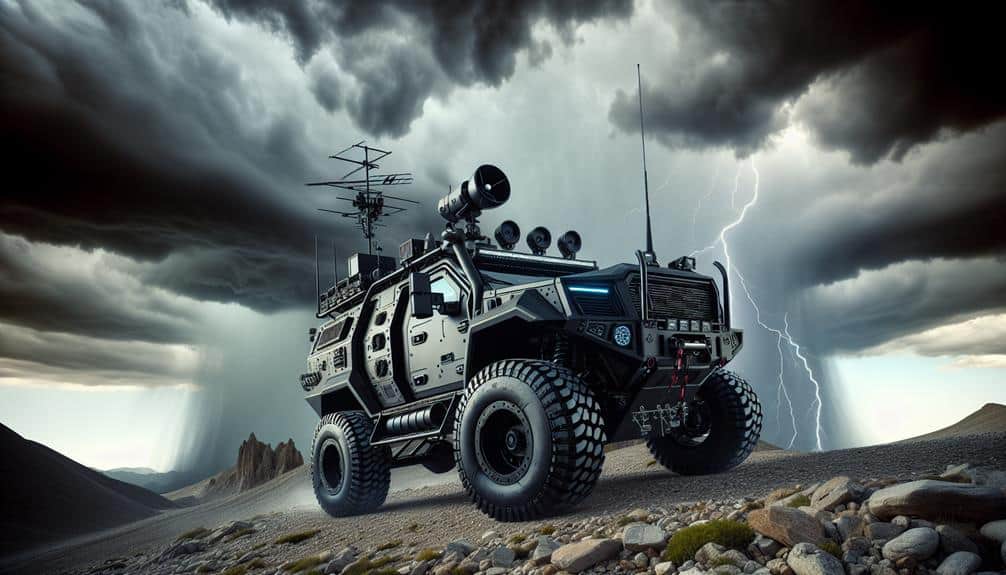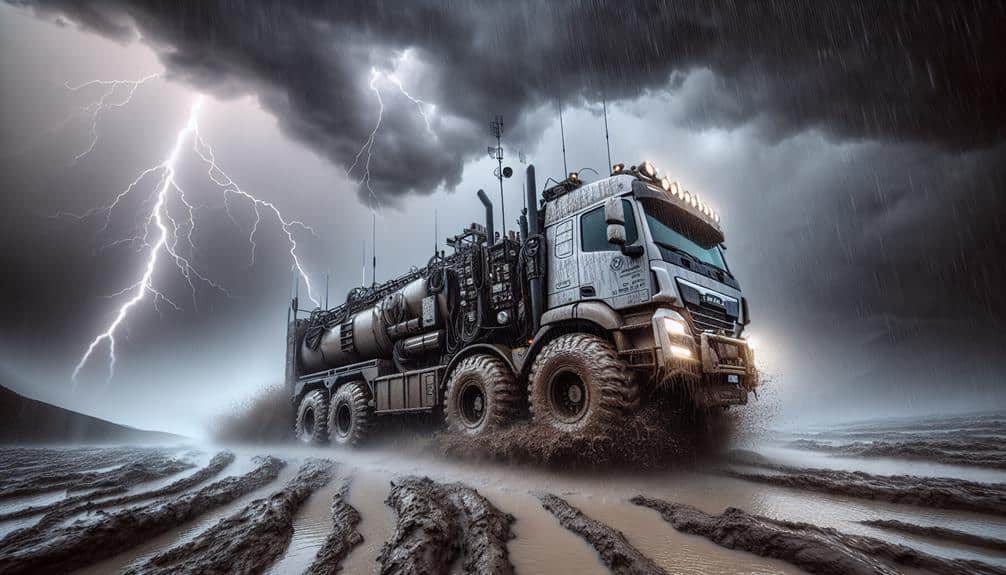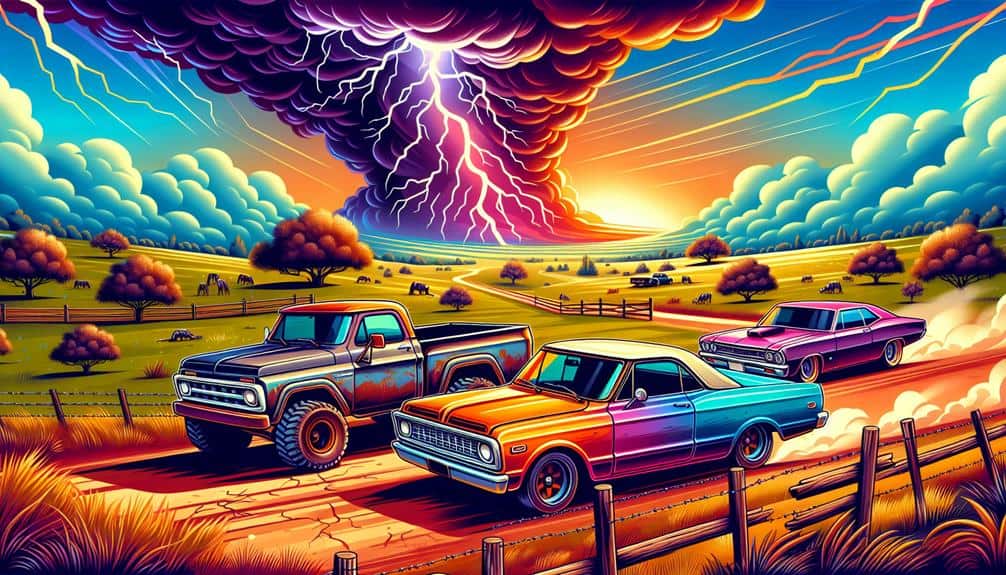We equip our storm chasing vehicles with cutting-edge radar systems that provide real-time data for precise weather tracking. High-resolution cameras, including night vision and 360-degree capabilities, guarantee detailed analysis despite low-light conditions. Reinforced vehicle armor, including undercarriage protection, enhances durability and safety against flying debris. Advanced weather monitoring sensors like anemometers and barometers deliver critical real-time storm metrics. Robust communication systems, including satellite and dual-band radios, ensure continuous updates and coordination. Emergency safety gear, from survival kits to portable shelters, safeguards team well-being. For a deeper exploration of these advancements, we provide more detailed information.
Key Points
- Advanced radar systems with Doppler technology for real-time storm tracking and analysis.
- High-resolution cameras with night vision for clear imagery in low-light storm conditions.
- Reinforced vehicle armor to protect against flying debris and extreme weather impacts.
- Weather monitoring sensors providing real-time data on storm metrics and patterns.
Advanced Radar Systems
Advanced radar systems provide us with important, real-time data that greatly enhances our ability to predict and track severe weather events. By integrating state-of-the-art Doppler technology, we can measure the velocity of particles within a storm, giving us unprecedented insight into its inner workings. This data is crucial for precise data analysis, allowing us to make informed decisions while chasing storms.
In our storm chasing vehicles, these advanced radar systems are essential. They help us pinpoint the exact location, movement, and intensity of weather phenomena. The radar's Doppler capabilities enable us to detect rotation within supercell thunderstorms, which is important for identifying potential tornado formation. This level of detail is necessary for ensuring our safety while maximizing our ability to gather valuable information.
Moreover, the data analysis derived from these advanced radar systems empowers us to anticipate changes in storm behavior with remarkable accuracy. By continuously monitoring the radar outputs, we can adjust our routes and strategies in real-time. This enhances our operational efficiency and guarantees we capture the most relevant and impactful data.
Our commitment to leveraging cutting-edge radar technology underscores our dedication to freedom and precision in storm chasing.
High-Resolution Cameras
Let's focus on the critical role of high-resolution cameras in our storm chasing endeavors.
These cameras provide superior image quality, enabling us to capture detailed visuals of storm structures.
Additionally, their exceptional low-light performance guarantees we can document phenomena accurately even in poor lighting conditions.
Superior Image Quality
High-definition cameras provide storm chasers with unmatched image clarity, allowing for detailed analysis of severe weather phenomena. By integrating advanced image stabilization, we guarantee that even in turbulent conditions, our footage remains sharp and steady. This stability is essential for precise data collection and analysis, minimizing distortion and maximizing the accuracy of our observations.
Additionally, night vision capabilities enable us to capture high-quality images during low-light conditions, extending our ability to monitor storms beyond daylight hours. This feature is vital for chronicling nocturnal weather events, giving us a thorough view of storm behavior at all times.
To further enhance our coverage, we utilize 360-degree cameras that offer a complete panoramic view of the environment. This all-encompassing perspective allows us to observe and record the storm's entire structure and movement, providing a wealth of data for meteorological analysis.
Combined with real-time streaming, these high-definition cameras allow us to share live footage instantly with our team and the broader community, facilitating immediate decision-making and collaborative analysis.
Incorporating these advanced camera technologies into our storm chasing vehicles ensures we capture the highest quality visual data, empowering us with the freedom to explore and document severe weather with unparalleled precision.
Low-Light Performance
Utilizing our night vision capabilities, we achieve superior low-light performance with high-resolution cameras, guaranteeing clear and detailed images even in the darkest storm conditions. Our advanced imaging technology utilizes highly sensitive sensors that capture maximum light, greatly enhancing visibility during nighttime chases. This secures we can document storm behavior with unparalleled clarity, providing vital data when visibility is typically compromised.
High-resolution cameras equipped with night vision not only enhance our observational accuracy but also contribute to safety. By improving visibility, we can detect and react to sudden changes in weather patterns more effectively. These cameras use a combination of infrared illumination and image processing algorithms to produce sharp, high-contrast images regardless of the ambient light conditions.
Our commitment to technological excellence means we're always at the forefront of innovation. We select cameras that offer the best low-light performance, ensuring our footage remains top-tier. This dedication to improved visibility allows us freedom to chase storms with confidence, knowing our equipment won't let's down. Ultimately, the integration of night vision capabilities in our high-resolution cameras transforms our storm chasing experience, making it safer and more successful.
Reinforced Vehicle Armor
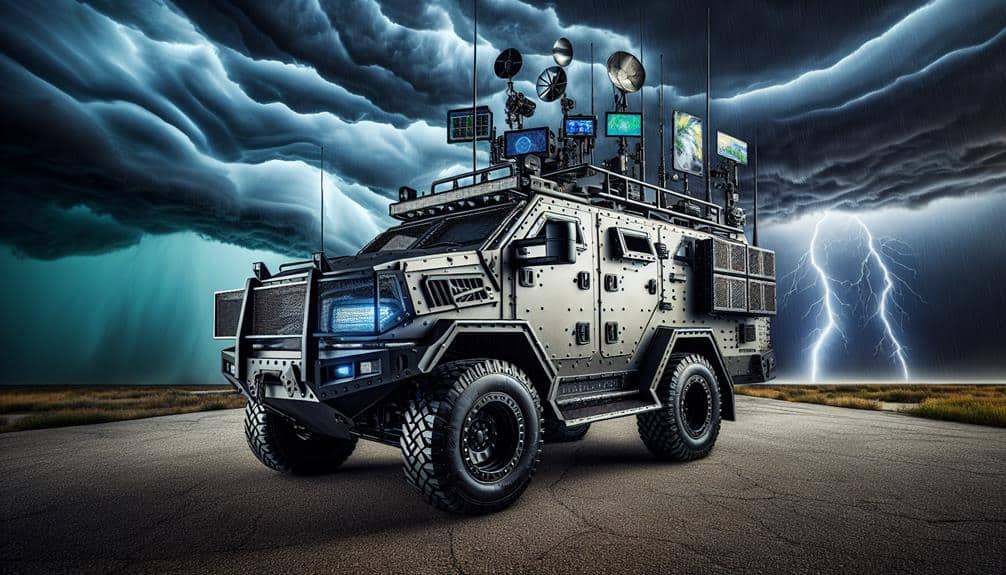
Reinforced vehicle armor is essential for ensuring the safety and durability of storm chasing vehicles in extreme weather conditions. When we're out in the field, our primary concern is vehicle protection. Armored plating plays a pivotal role in shielding our vehicles from flying debris and high-speed projectiles. This armored plating is typically made from high-strength steel or composite materials, designed to provide robust defense without compromising mobility.
Incorporating advanced safety features, we can greatly enhance our impact resistance. Reinforced bumpers and side panels are specifically engineered to absorb and dissipate kinetic energy during collisions, reducing the risk of structural damage. Additionally, undercarriage armor protects essential components like the fuel tank and drivetrain, preventing catastrophic failures during intense storm encounters.
Our commitment to safety doesn't end with structural reinforcements. We also focus on optimizing the vehicle's weight distribution to maintain stability in high winds. Strategically placed reinforcements ensure that the added weight of the armor doesn't negatively affect handling or performance.
In doing so, we create a balanced storm chasing vehicle that offers both protection and agility, allowing us to navigate treacherous conditions with confidence and freedom.
Weather Monitoring Sensors
While reinforced vehicle armor guarantees our safety, equipping our storm chasing vehicles with advanced weather monitoring sensors is essential to accurately tracking and analyzing storm patterns. High-quality anemometers, barometers, and hygrometers provide real-time data on wind speed, atmospheric pressure, and humidity levels. These sensors are vital for capturing detailed storm metrics, allowing us to predict storm behaviors with greater accuracy.
Remote monitoring capabilities enable us to collect and analyze data without physically exposing ourselves to hazardous conditions. By utilizing satellite data links and mobile networks, we can continuously monitor storm developments from a secure location. This real-time data feeds directly into our onboard systems, enhancing our situational awareness and enabling more informed decision-making.
Sophisticated data analysis tools are integrated with our sensor arrays, allowing for immediate processing and visualization of collected information. This capability helps us identify crucial patterns and anomalies, providing a clearer understanding of storm dynamics. By analyzing these data points, we can forecast potential storm paths and intensities, ensuring that we stay ahead of the weather.
Incorporating advanced weather monitoring sensors into our vehicles not only enhances our safety but also empowers us with the freedom to navigate and study storms more effectively.
Communication Enhancements
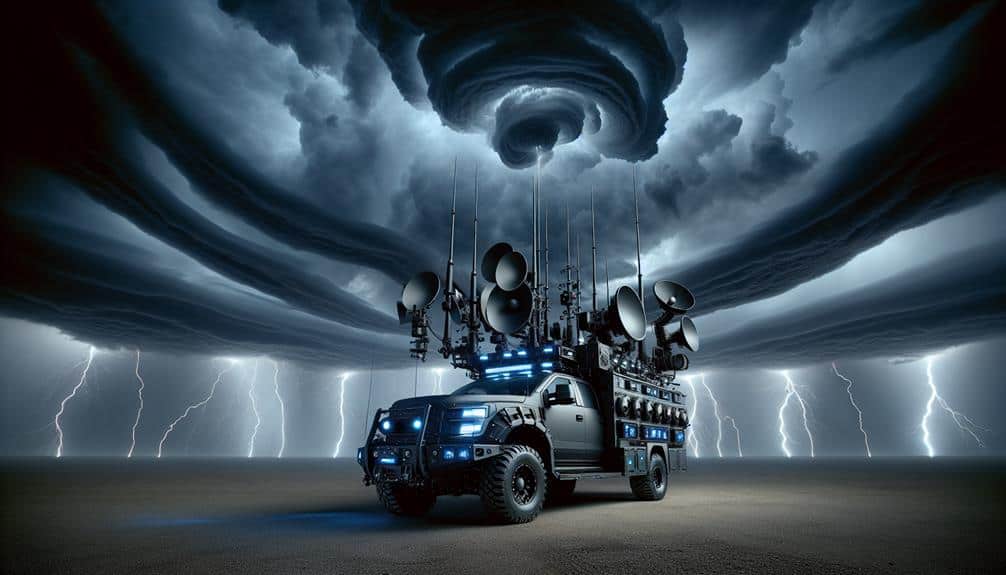
To maintain continuous communication during storm chasing missions, we integrate advanced radio systems and satellite communication devices into our vehicles. This guarantees we receive real-time updates essential for making informed decisions.
Let's explore the specific technologies we use:
- Satellite Communication Systems: These provide reliable connectivity even in remote areas where cellular networks fail. We can send and receive critical information without interruption.
- Dual-Band Radios: Utilizing both VHF and UHF frequencies, these radios allow us to communicate with emergency services and other storm chasers efficiently.
- Mobile Data Terminals (MDTs): Equipped with GPS and internet connectivity, MDTs enable us to access weather reports, maps, and other necessary data in real time.
- In-Vehicle Wi-Fi Hotspots: These hotspots guarantee all devices within the vehicle can connect to the internet, facilitating seamless communication and data transfer.
Emergency Safety Gear
Outfitting our storm chasing vehicles with top-tier emergency safety gear is vital for ensuring our team's well-being in hazardous conditions. First and foremost, all-inclusive survival kits are a necessity. These kits should include first aid supplies, water purification tablets, multi-tools, thermal blankets, and high-calorie energy bars. By having these essentials on hand, we can address both minor injuries and potential dehydration or hypothermia.
Another essential component is the inclusion of portable emergency shelters. These shelters provide immediate protection against severe weather when evacuation isn't an option. Lightweight and compact, they can be quickly deployed to shield us from high winds, rain, and flying debris. It's important to choose shelters made from durable materials that can withstand the elements while being easy to set up and pack away.
Moreover, we should integrate high-visibility gear, such as reflective vests and LED flares, into our emergency safety equipment. These items are vital for maintaining visibility in low-light conditions and ensuring that rescue teams can locate us if necessary.
Frequently Asked Questions
How Do You Prepare a Storm Chasing Route?
We prioritize route planning and safety precautions. We use real-time data, establish emergency communication, and design backup plans. It's essential to analyze weather patterns and guarantee our route allows quick adjustments for safety and effective storm chasing.
What Are the Best Apps for Real-Time Weather Updates?
We've found that apps like RadarScope and WeatherBug provide the best real-time weather updates. They offer precise weather radar and alerts, GPS tracking, and essential safety precautions, ensuring we're always informed and safe during our adventures.
How Do You Stay Fueled During Long Chases?
We stay fueled during long chases by packing ample food supplies like snack bars and using a portable stove for hot meals. Energy drinks provide quick boosts, ensuring we remain alert and ready for any situation.
What Are the Legal Restrictions for Storm Chasing?
'Better safe than sorry,' we always say. Legal restrictions for storm chasing include respecting privacy concerns and minimizing environmental impact. We must avoid trespassing on private property and make sure we're not harming natural habitats during our pursuits.
How Do You Maintain Vehicle Performance in Extreme Weather?
We guarantee vehicle maintenance by employing advanced weatherproofing techniques and performance optimization strategies. Regular checks in extreme conditions help maintain peak performance, providing the freedom to chase storms safely and efficiently.
